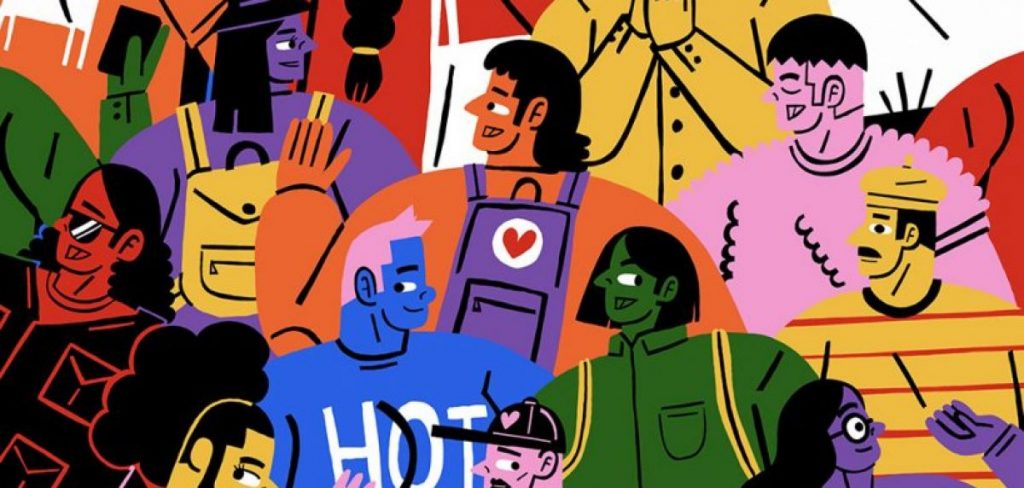For my intervention I want to design a mode of working with a tutor group throughout a year that allows us to hold space for social justice, accessibility and collective care throughout the year.
This has been informed throughout discussions with my colleague Jayoon Choi who co-teaches social justice on the Illustration degree where I currently work and from feedback from other colleagues on the course.
I also want to build upon my blog group partner Kelly Harrison’s work. Kelly is designing an intersectionality visualisation exercise that I would like to incorporate into my intervention.
I still need to write my introduction statement and fine tune the logistics of getting feedback from students, but I feel proud of my idea so far.
Draft:
Step 1: Intro myself and the space to students
- Maybe a video?
- Or maybe organize an in-person intro.
Step 2: Share draft code of conduct (things that I want to uphold)
- Social justice
- Anti racism
- Pro LGBT space
- Neurodiverse and disability informed
- Class divides?
- Establish brave space as a context for being challenged
Step 3: Option to provide anonymous feedback and ideas (Agency for students)
- What do you need in the space to feel seen and respected?
- What do you need to feel included?
- What do you need to feel confident?
Step 4: Make sure they know it will be read collectively at group meetings and workshops
- Allow space for feedback and changes at every workshop
- Verbal and anonymous throughout the year
- It is ok to opt out from reading aloud but I will make it clear that I will push people to be brave and read together, and asking the group to provide a supportive atmosphere to cheer each other on.
Step 5: At the end of the year, we will compare the original manifesto with the most recent one.

Hi Fred
I hope that you are well. Thank you for sharing your intervention design ideas. I thought the phrasing of the intervention is interesting ‘design a mode of working’ and opens up the discussion as to how this would be different to a code of conduct or manifesto, and the extent to which you can design a way of working or just agree to one (or have one imposed). You talk about sharing a draft code of conduct including things you want to uphold, just wondering if you were planning this to be a collective effort. Could students create the first draft based on a suggested framework in terms of what you want to achieve? This might increase ownership and mitigate the risk of students feeling like values are imposed from above. In this sense perhaps it’d be good to pinpoint what the actual intervention is e.g. Developing and embedding a co-created, evolving tutor group manifesto focused on social justice, accessibility, and collective care, revisited throughout the year in group sessions.
In any case, I like the fact that your proposal is less about ‘delivering content’ inclusively and more about shaping a culture that supports inclusion, vulnerability, and accountability (through brave spaces), so it clearly aligns with LO4 and if it’s a co-created code of conduct, then it aligns well with LO2. You may also want to consider how it aligns with/responds to/critiques/considers/builds on guidance on inclusive practices from UAL, relevant industry bodies, sector frameworks (e.g. Advance HE), ongoing debates (freedom of expression) etc to help demonstrate LO1.
In terms of LO2, incorporating some of the relevant literature would be good. For example, Malcolm (2021) discusses freedom of speech and silencing, which can also happen unintentionally in education spaces. Rekis’ (2023) ideas may help you frame co-creation in your intervention as a move against epistemic injustice by giving value to students’ diverse ways of knowing and being. In terms of LO3, you demonstrate self-awareness and intention, but consider articulating more clearly what informs your own stance. For example, why do these values matter to you as a tutor, facilitator, educator, practitioner? How do different aspects of your identity influence your teaching or facilitation approach? Referencing Bayeck (2022) or Schiffer (2020) could help explore that positionality more fully.
There are some resources below you may find useful and I’ve included the learning outcomes too to provide a focus for the reflective report when you come to it.
Regards, Victor
Rekis, J. (2023) Religious identity and epistemic injustice:
Malcolm, F. (2021) Silencing and Freedom of Speech in UK Higher Education
Bayeck, R. (2022) Positionality in
Advance HE (2021). Embedding Inclusive Teaching and Learning
Offers guidance on aligning inclusive curriculum design with national HE policy.
https://www.advance-he.ac.uk/knowledge-hub/framework-inclusive-learning-and-teaching
Below, just a reminder of the learning outcomes.
LO1: Critically evaluate institutional, national and global perspectives of equality and diversity in relation to your academic practice context. [Enquiry]
LO2: Manifest your understanding of practices of inequity, their impact, and the implications for your professional context. [Knowledge]
LO3: Articulate the development of your positionality and identity through the lens of inclusive practices. [Communication]
LO4: Enact a sustainable transformation that applies intersectional social justice within your practice. [Realisation]